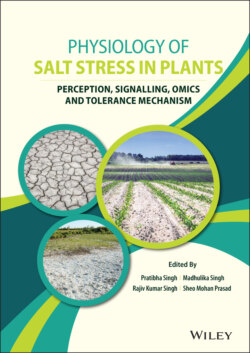Читать книгу Physiology of Salt Stress in Plants - Группа авторов - Страница 10
Оглавление
Preface
This edited book entitled Physiology of Salt Stress in Plants: Perception, Signalling, Omics and Tolerance Mechanism is an important contribution to Plant Science containing information related to salt stress and its mitigation strategy by experimental techniques based on theoretical concepts. The salt‐stress‐related problems are rising in the soil and water due to natural and anthropogenic activities. Anthropogenic activities include repeated irrigation through canal system and heavy crop production practices which has led to enhanced salt level in crop/agricultural field, hence substantially declining the crop productivity. Therefore, study on salt toxicity is continued as an area of scientific interest in direction to understand their whole mechanism of its toxicity and their entry into crop plants.
In this book, the authors explain a number of approaches to ease the negative impact of salt stress in crop plants. These approaches include nutrients, antioxidants, osmolytes, phytohormones and extra cellular compounds, etc. They are endo as well as exogenous in nature. In this book, the adverse impact of salt ion toxicity on plants and implication of advance approaches in alleviating salt toxicity have briefly been reviewed. This work enables the scientific world to design strategies for reducing NaCl‐mediated loss to crop by the application of different endo and exogenous substances in the farm soils. The governments and other organizations may design a holistic approach to reduce NaCl and other salt toxicity by different types of practices. Agriculturalists may be enlightened with several awareness programmers by the government and non‐government actions wherein the content of this book may be used. It is widely useful for all post‐graduate courses in the biological sciences. The idea of this work has a wide‐ranging scientific and socio‐economic utility.
All the editors thankfully acknowledge the contributions from all the scholars working across the Indian subcontinent and across the world. An authoritative book written by an individual that remains relevant over the coming years is rather cumbersome and instead requires the concerted effort of a team of expert scientists. All editors also gratefully acknowledge the team at John Wiley & Sons Limited which made possible the proposed book in its present form.
Editors
Pratibha Singh
Madhulika Singh
Rajiv Kumar Singh
Sheo Mohan Prasad
